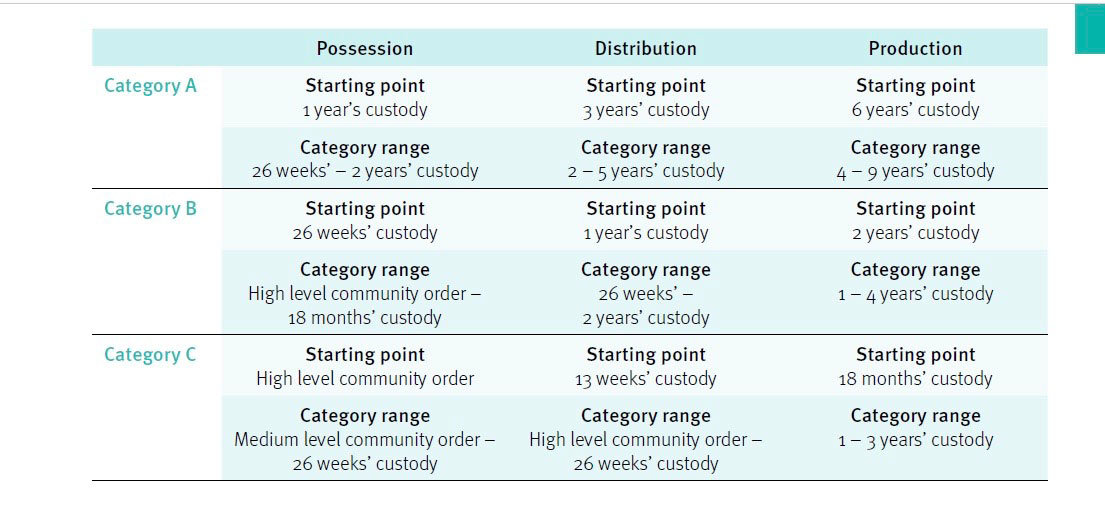Written 19th April 2020 by Ruth Peters
In this article we consider sentencing in relation to offences of indecent images and whether a custodial sentence is likely
If you are found guilty of an indecent images offence, you could face a custodial sentence. Being found guilty however does not mean that you will definitely go to prison. There is in fact a range of options available to the court when sentencing a person who has been convicted of these types of offences. This range will depend upon what category the offence falls into i.e. the level of seriousness of the material found.
On this basis, the court will use a set of guidelines to determine the appropriate sentence. They will take in to consideration both aggravating and mitigating factors, which will differ depending on each individual case.
The least serious offences i.e. possession of category C images, are usually dealt with by way of a community order. This may be an appropriate alternative to a short or moderate length custodial sentence where there is a sufficient prospect of rehabilitation and the order can include a sex offender’s treatment programme. Otherwise, those offences of a more serious nature are typically dealt with by custodial sentences. These can range from a number of weeks, for example 26, to a starting point of 6 years’ for the most serious offences. A person convicted of indecent images offences may also be made subject to Sexual Harm Prevention Orders and be placed on the Sex Offender’s Register.
It is important to note that the court will look at each case on an individual basis, taking in to consideration a person’s background, personal circumstances and any applicable aggravating and mitigating factors.
Which legislation covers indecent images?
The following two pieces of legislation set out offences concerning indecent images:
Section 1 of the Protection of Children Act 1978 (PCA 1978)
1) This makes it an offence for a person:
a) To take, permit to be taken or to make any indecent photograph or pseudo photograph* of a child; or
b) To distribute or show such indecent photographs or pseudo photographs;
c) To possess such indecent photographs or pseudo photographs with a view to their being distributed or shown by himself or others; or
d) To publish or cause to be published any advertisement likely to be understood as conveying that the advertiser distributes or shows such indecent photographs or pseudo photographs or intends to do so.
2) The following defences apply to an offence committed under subsection (b) or (c) above:
a) A person must prove that he had a legitimate reason for distributing or showing the indecent photographs or pseudo photographs or (as the case may be) having them in his possession; or
b) A person must prove that he had not himself seen the indecent photographs or pseudo photographs and did not know, nor had any cause to suspect, them to be indecent.
* Images made by computer graphics, or otherwise, which appear to be photographs.
Section 160 of the Criminal Justice Act 1988 (CJA 1988)
1) This makes it an offence for a person to possess any indecent photograph or pseudo photograph of a child.
2) It is a defence if a person can prove the following:
a) That he had a legitimate reason for having the indecent photograph or pseudo photograph in his possession; or
b) That he had not himself seen the indecent photograph or pseudo photograph and did not know, nor had any cause to suspect, it to be indecent; or
c) That the indecent photograph or pseudo photograph was sent to him without any prior request by him or on his behalf and that he did not keep it for an unreasonable time.
Note that offences committed under section 1 of the PCA 1978, and section 160 of the CJA 1988, are either way offences. This means that they can be dealt with in either the magistrates’ court or the crown court depending on the level of seriousness. If dealt with in the magistrates’ court, a maximum term of 6 months’ imprisonment can be imposed and/or a fine. Alternatively, if dealt with in the crown court a maximum term of 5 years’ imprisonment can be imposed for offences committed under section 160 of the CJA 1988, or a maximum term of 10 years’ for offences committed under section 1 of the PCA 1978.
What are the different categories of images?
Indecent images can fall into three categories depending on their seriousness:
Category A – this is the most serious category and relates to images involving penetrative sexual activity, sexual activity with an animal or sadism.
Category B – this category relates to images involving non-penetrative sexual activity.
Category C – this category concerns images which do not fall in to categories A or B.
Whatever category the indecent images fall into will determine how the case will be dealt with for the purposes of sentencing. Category A offences carry more serious consequences in contrast to category C offences which can result in varying levels of community orders. Once the category has been determined, the court will look at what was done with the images i.e. possession, distribution and/or production.
Possession is simply having the images stored on a device i.e. having control over them. Distribution on the other hand is parting with possession of the images and therefore exposing or offering them for acquisition by another. Production relates to the making of the original images and can also including downloading an image onto a device although, for sentencing purposes, this would be treated as possession.
Sentencing
Click here to view the sentencing guidelines for indecent images offences.
These guidelines will be used by the judge to sentence an individual who has been found guilty of an offence. Various factors, both aggravating and mitigating, will be taken in to consideration when a person is sentenced. The starting points shown in the table below apply to all offenders irrespective of their previous convictions or whether they have pleaded guilty or not guilty. The court will look at the corresponding starting point to reach a sentence within the applicable category range, as shown in the following table:

Having determined the starting point and category range, aggravating and mitigating features will then be considered. Aggravating factors may adjust the sentence upwards and include, for example, whether the individual has relevant previous convictions, has abused a position of trust or has a large volume of images. On the other hand, mitigating factors could be that the individual has shown genuine remorse and has taken steps to address their behaviour, all of which can contribute to a reduction of sentence.
How can I reduce the risk of receiving a custodial sentence?
Facing accusations of indecent images offences can be particularly daunting and cause an individual to be concerned, amongst other things, about damage to their reputation, the effect on their family and the potential imposition of a prison sentence. At Olliers Solicitors, we can offer essential advice and representation at all stages of the process, from arrest and interview at the police station to the case being sent to the Crown Prosecution Service for a charging decision. We focus on supporting and reassuring the client from the outset, clearly explaining the processes involved and ensuring that we prepare their case as thoroughly as possible. Any work done pre-charge is important for establishing contact with the investigating officer to help navigate the investigation and anticipate how the case is to be dealt with.
It is possible to avoid a conviction altogether in circumstances where we are able to persuade the Crown Prosecution Service that there is not a ‘realistic prospect of conviction’ nor is it in the ‘public interest to prosecute’. We are able to put forward to both the police and the Crown Prosecution Service helpful mitigation to assist in arguing these points.
If you are under investigation for indecent images offences, there are things you can put in place to show that you are working towards addressing your offending behaviour and focussing on rehabilitation. You can take part in structured programmes run by specialist organisations to gain a better understanding of your behaviour and put the appropriate mechanisms in place to safeguard you from re-offending. One such organisation is Safer Lives, a leading UK agency offering support for those who have committed online sexual offences.
Specialist indecent image lawyers
Article written by Ruth Peters. Please get in touch with us at Olliers for expert advice and support concerning indecent images offences.
Manchester
Head Office
- 0161 8341515
- info@olliers.com
- Fourth Floor, 44 Peter Street, Manchester, M2 5GP
- About the Author
- Latest Posts
Ruth leads the business development team at Olliers across all areas of specialism. Ruth was the Manchester Legal Awards 2021 Solicitor of the Year.
She has been with the firm for more than 20 years and has an enviable level of experience across the entire spectrum of criminal defence.


